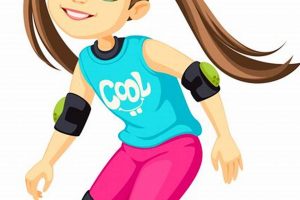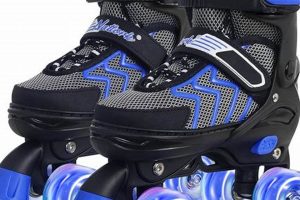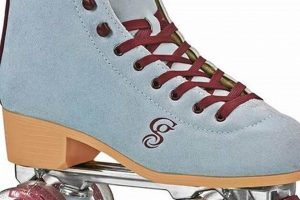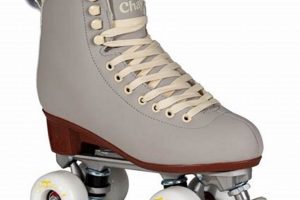Acquiring the skill of moving on wheeled boots, often in a recreational or athletic context, involves developing balance, coordination, and specific techniques. This pursuit combines elements of physical exercise and enjoyment, fostering a sense of accomplishment as proficiency increases. For example, individuals might begin by practicing basic movements on a smooth, flat surface before progressing to more complex maneuvers.
The advantages of mastering this activity extend beyond mere amusement. It contributes to improved cardiovascular health, strengthens leg muscles, and enhances overall agility. Furthermore, it provides a social outlet, allowing participants to engage in group activities and build camaraderie. Historically, this mode of movement has evolved from a simple novelty to a recognized sport, featuring various disciplines and competitive events.
The subsequent sections will address essential equipment considerations, fundamental techniques, common challenges encountered during the initial stages, and strategies for overcoming these hurdles. This will provide a structured approach to facilitating a smoother and more rewarding experience for beginners.
Essential Guidance for Initial Roller Skating Instruction
The following recommendations are designed to facilitate effective acquisition of roller skating proficiency, emphasizing safety and proper technique.
Tip 1: Prioritize Protective Gear. The consistent use of a certified helmet, wrist guards, elbow pads, and knee pads is paramount to minimize the risk of injury during initial instruction. Evaluate equipment condition prior to each session.
Tip 2: Select an Appropriate Learning Environment. Opt for a smooth, flat surface, free from obstructions and vehicular traffic. Indoor skating rinks or designated outdoor areas are suitable options for controlled practice.
Tip 3: Master the Stance. A balanced stance, characterized by slightly bent knees, a forward lean of the upper body, and feet positioned shoulder-width apart, provides stability and control. Consistent practice of this posture is critical.
Tip 4: Practice Controlled Falls. Deliberately practicing how to fall safely, by aiming to land on padded areas and rolling to dissipate impact force, can reduce the severity of potential injuries. Integrate this exercise into the training routine.
Tip 5: Develop the “Duck Walk” Technique. Propelling oneself forward using small steps with heels together and toes pointed outward enhances balance and coordination. This maneuver is a foundational skill for forward movement.
Tip 6: Implement Incremental Skill Progression. Gradually increase the difficulty of exercises as proficiency improves. Avoid attempting advanced maneuvers before mastering fundamental techniques to mitigate the risk of errors and injuries.
Tip 7: Seek Qualified Instruction. Consulting with a certified roller skating instructor provides personalized guidance, technique correction, and structured progression plans. Professional oversight can significantly enhance the learning curve.
Adherence to these guidelines promotes a safer and more efficient learning experience, enabling individuals to develop roller skating skills with greater confidence and competence.
The subsequent section will address common obstacles encountered during the initial stages and methods for overcoming these challenges.
1. Balance
Balance constitutes a foundational element in the acquisition of roller skating proficiency. Its absence directly impedes progress, resulting in instability and increased risk of falls. Effective balance while roller skating involves maintaining a low center of gravity, engaging core muscles, and distributing weight evenly across both skates. For example, novice skaters often struggle with balance due to a lack of core strength or an improperly aligned posture. Correcting these issues allows for improved control and stability during movement.
The relationship between balance and roller skating is reciprocal. The act of roller skating itself, when practiced consistently and with proper technique, serves to enhance one’s natural sense of balance. This improvement translates not only to greater ease and fluidity while skating but also to improvements in balance during other physical activities. Consider the parallel between a skater’s refined balance and an ice skater’s control on a slippery surface; both disciplines necessitate exceptional balance. The practical application extends beyond athletic pursuits. Improved balance reduces the risk of falls in everyday life, particularly for elderly individuals.
In summary, the ability to maintain balance is essential for both initial learning and subsequent mastery of roller skating. While challenges related to balance may present obstacles for beginners, targeted exercises and mindful attention to posture and weight distribution can mitigate these difficulties. The correlation between balanced skating technique and reduced fall risk reinforces the importance of its cultivation.
2. Coordination
Coordination, in the context of roller skating, represents the harmonious interaction of multiple muscle groups and sensory inputs to produce controlled and fluid movements. Its significance as a component of acquiring roller skating skills cannot be overstated. An observable cause-and-effect relationship exists; deficient coordination manifests as jerky, uncontrolled movements and an increased propensity for falls, while improved coordination allows for smoother transitions, greater stability, and the execution of more complex maneuvers. A common example illustrates this point: a beginner skater may struggle to simultaneously maintain balance, propel forward, and steer, resulting in a loss of control. With focused practice, the individual gradually develops the ability to coordinate these actions, resulting in improved skating performance.
The development of coordination in roller skating involves the integration of visual, vestibular, and proprioceptive information. Visual input provides feedback on the skater’s position relative to the surrounding environment. The vestibular system, located in the inner ear, contributes to balance by detecting changes in head position and acceleration. Proprioception, the body’s sense of its own position and movement, allows the skater to monitor the position and force exerted by various muscle groups. Over time, the skater’s nervous system learns to anticipate the necessary muscle activations to maintain balance and execute desired movements, resulting in increased efficiency and decreased cognitive load. This is practically demonstrated when a skater can navigate an obstacle course seemingly effortlessly, reacting instinctively to changing conditions without conscious deliberation.
In summary, coordination plays a critical role in learning to roller skate, dictating the smoothness, control, and complexity of attainable movements. Improving coordination requires dedicated practice, integrating sensory feedback, and developing anticipatory motor control. The ability to effectively coordinate body movements is paramount not only for achieving proficiency but also for minimizing the risk of injuries and maximizing the overall enjoyment derived from the activity.
3. Technique
Technique, in the context of acquiring roller skating skills, constitutes the specific methods and procedures employed to execute movements effectively and efficiently. A demonstrable cause-and-effect relationship exists between proper technique and performance; incorrect technique results in inefficient energy expenditure, reduced control, and increased risk of injury, whereas refined technique maximizes efficiency, enhances control, and minimizes the potential for harm. For instance, failing to maintain a proper stance, characterized by bent knees and a low center of gravity, directly compromises balance and increases the likelihood of falls. Conversely, mastering the “T-stop” braking technique provides a controlled and reliable method for decelerating and stopping, thereby enhancing safety and control.
The importance of technique stems from its impact on multiple facets of roller skating. Firstly, proper technique promotes efficiency. Optimizing movements reduces the energy required to perform a given task, enabling skaters to maintain activity for extended periods. Secondly, technique directly influences control. Refined techniques, such as edge control and weight shifting, allow skaters to precisely navigate and maneuver, enhancing their ability to respond to changing conditions. Thirdly, and perhaps most significantly, correct technique minimizes the risk of injury. Utilizing proper braking techniques and falling correctly are crucial for mitigating the impact of unexpected events and preventing serious harm. Consider the experience of a skater attempting a jump without adequate preparation and proper landing technique. The resulting uncontrolled landing is far more likely to result in injury compared to a jump executed with precision and control.
In summary, the effective acquisition of roller skating skills relies heavily on mastering appropriate techniques. Technique’s effect on energy efficiency, control, and safety highlights its practical significance. While learning correct technique requires dedication, practice, and potentially guidance from experienced instructors, the benefits are considerable. By prioritizing technique, learners can improve their performance, minimize the risk of injury, and maximize their enjoyment of the activity. The challenges encountered during the technique acquisition phase are often temporary and can be overcome through focused effort and consistent practice, leading to sustained progress and a safer, more rewarding experience.
4. Safety
Safety constitutes a critical and non-negotiable component of the process of learning to roller skate. The inherent nature of the activity, involving dynamic movement on wheeled footwear, presents an elevated risk of injury if appropriate precautions are not diligently observed. A direct cause-and-effect relationship exists: the neglect of safety measures results in an increased probability of accidents and subsequent physical harm, while the consistent implementation of safety protocols significantly reduces the potential for injury. For instance, a novice skater who forgoes the use of protective gear, such as a helmet and wrist guards, is substantially more vulnerable to head trauma and wrist fractures in the event of a fall compared to one who utilizes these protective measures. This underscores the practical importance of prioritizing safety from the outset of the learning process.
The significance of safety in roller skating extends beyond the immediate prevention of injuries. It also fosters a more positive and productive learning environment. When learners feel secure and protected, they are more likely to engage in practice with confidence and to experiment with new techniques without undue fear. This psychological aspect contributes to accelerated skill development and a more enjoyable learning experience. Furthermore, adherence to safety guidelines cultivates responsible behavior, promoting a culture of safety within the broader roller skating community. Consider the example of a skating group where all members consistently wear appropriate protective gear and adhere to traffic regulations. This collective demonstration of safety consciousness reinforces the importance of these practices and encourages others to adopt similar habits.
In summary, the effective acquisition of roller skating skills necessitates a strong emphasis on safety. Safety isn’t an ancillary consideration but is an integral element that directly influences the learner’s physical well-being, psychological comfort, and overall learning progress. Overcoming challenges related to safety, such as resistance to wearing protective gear or neglecting to assess environmental hazards, requires education, reinforcement, and a commitment to responsible behavior. Integrating a safety-conscious approach from the start ensures a more secure, rewarding, and sustainable roller skating journey. The long-term benefits of prioritizing safety far outweigh any perceived inconvenience or discomfort associated with implementing appropriate precautions.
5. Practice
Consistent practice is paramount in acquiring and refining roller skating skills. It forms the cornerstone of skill development, transforming theoretical knowledge into practical competence. Without dedicated practice, progress is often limited and inconsistent. The following facets highlight the pivotal role of practice in learning to roller skate.
- Skill Acquisition
Practice facilitates the acquisition of fundamental roller skating skills, such as maintaining balance, propelling forward, and executing basic turns. Repetition of these movements builds muscle memory and enhances coordination, leading to greater fluency and control. For example, repeatedly practicing the “duck walk” technique allows beginners to gradually internalize the necessary movements and improve their stability on skates. Lack of dedicated practice impedes the development of these foundational skills, making further progress difficult.
- Technique Refinement
Through consistent practice, skaters can refine their technique, optimizing their movements for efficiency and control. Repeatedly performing specific maneuvers, such as the “T-stop” or crossover turns, allows skaters to identify and correct flaws in their technique, resulting in smoother, more controlled execution. Regular practice under the guidance of an instructor can further accelerate technique refinement. A skater who consistently practices their braking technique, for instance, will develop a more reliable and controlled stop, enhancing their safety and confidence.
- Overcoming Challenges
Practice provides a mechanism for overcoming challenges and setbacks encountered during the learning process. New skaters often struggle with specific techniques or experience falls and frustration. Continued practice, despite these challenges, builds resilience and fosters a growth mindset. By repeatedly confronting and overcoming obstacles, skaters develop the mental and physical fortitude necessary to progress. An example is consistently attempting a difficult turn, even after several failed attempts, which cultivates persistence and ultimately leads to mastery.
- Maintenance of Skill
Consistent practice is crucial for maintaining roller skating skills over time. Skills acquired through initial learning can degrade without regular reinforcement. Periodic practice sessions help skaters retain muscle memory, coordination, and technique, ensuring that they can continue to enjoy and utilize their skills effectively. Even experienced skaters benefit from occasional practice to maintain their proficiency and prevent skill decay. For example, a skater who has not skated for several months may find that their balance and coordination have diminished, requiring a period of practice to regain their previous skill level.
These facets underscore the indispensable role of consistent practice in learning to roller skate. From acquiring fundamental skills to refining technique, overcoming challenges, and maintaining proficiency, practice provides the necessary foundation for progress and mastery. A structured and dedicated approach to practice maximizes learning outcomes and promotes a sustainable and enjoyable skating experience.
6. Persistence
Persistence is a critical determinant in the successful acquisition of roller skating proficiency. The learning curve often presents initial challenges, including balance issues, coordination difficulties, and the inevitable occurrence of falls. A direct correlation exists: diminished persistence precipitates stagnation or abandonment of the learning process, whereas sustained persistence cultivates skill development and eventual competence. A novice skater who discontinues practice due to early frustration is unlikely to progress, whereas an individual who perseveres despite initial setbacks demonstrates a higher probability of achieving their skating goals. This underscores the instrumental role of persistence in overcoming the inherent obstacles associated with the activity.
The significance of persistence extends beyond the mere acquisition of basic skating skills. It fosters the development of resilience, a valuable attribute applicable to diverse aspects of life. Overcoming challenges in roller skating, such as mastering difficult maneuvers or recovering from falls, strengthens an individual’s capacity to persevere through adversity. Moreover, the act of consistently practicing roller skating, despite potential setbacks, cultivates discipline and self-determination. Consider the example of a skater who initially struggles with the “crossover” turn. Through persistent practice and focused effort, the skater gradually refines their technique, eventually executing the maneuver with precision and control. This accomplishment not only enhances their skating ability but also instills a sense of self-efficacy and accomplishment.
In summary, persistence is an essential component in learning to roller skate, directly influencing the rate and extent of skill development. The connection between persistence and success in roller skating is demonstrable and multifaceted. By cultivating persistence, learners not only enhance their skating abilities but also develop valuable personal qualities that contribute to overall well-being and achievement. Addressing challenges related to motivation and maintaining consistent practice requires setting realistic goals, celebrating small victories, and seeking support from instructors or fellow skaters. The long-term benefits of persisting through the initial challenges of roller skating far outweigh the temporary discomfort or frustration experienced along the way.
7. Environment
The environment within which roller skating instruction occurs exerts a substantial influence on the learning process. A direct correlation exists between the suitability of the environment and the rate and effectiveness of skill acquisition. An unsafe or poorly maintained environment presents hazards that impede progress and increase the likelihood of injury. Conversely, a safe, well-maintained, and appropriately sized environment facilitates a positive and productive learning experience. For example, learning on a cracked and uneven surface significantly increases the risk of falls, whereas a smooth, flat surface promotes stability and control, allowing the learner to focus on developing technique without undue apprehension.
The characteristics of an optimal learning environment extend beyond mere physical safety. Factors such as adequate lighting, suitable temperature, and the absence of distractions also play a significant role. Insufficient lighting can impair visibility, increasing the risk of collisions or missteps. Extreme temperatures can lead to discomfort and reduced concentration. Distractions, such as excessive noise or pedestrian traffic, can disrupt focus and hinder the learning process. Consider the experience of a beginner attempting to learn roller skating in a crowded and noisy public park, contrasted with the same individual learning in a dedicated, controlled skating rink. The latter environment offers a more conducive setting for focused practice and skill development, free from the external pressures and distractions present in the public space.
In summary, the environment constitutes a crucial element in learning to roller skate, impacting safety, concentration, and overall learning effectiveness. Understanding the relationship between environmental factors and learning outcomes enables educators and learners to make informed decisions about selecting and preparing suitable practice locations. Addressing challenges related to environmental limitations, such as uneven surfaces or inadequate lighting, may involve selecting alternative locations, modifying existing surfaces, or adjusting practice schedules to coincide with optimal conditions. By prioritizing environmental considerations, learners can create a more positive, productive, and safe roller skating experience. The practical significance of this understanding lies in the ability to minimize risks, maximize learning potential, and foster a sustained interest in the activity.
Frequently Asked Questions about Learning to Roller Skate
The following questions address common concerns and misconceptions encountered during the roller skating learning process. The aim is to provide clear and concise answers based on established principles and practices.
Question 1: Is a high degree of athletic ability required to begin learning to roller skate?
No, while prior athletic experience can be beneficial, it is not a prerequisite. Basic physical coordination and a willingness to learn are the primary requirements. The initial stages focus on fundamental skills, and physical strength and endurance will develop progressively with consistent practice.
Question 2: What is the minimum recommended age for starting roller skating lessons?
The appropriate age depends on the individual child’s physical development and attention span. Generally, children around the age of five or six may be ready to begin learning, provided they possess sufficient coordination and the ability to follow instructions. Formal instruction should be tailored to the child’s developmental level.
Question 3: How much time is typically required to achieve a basic level of competence in roller skating?
The time required varies depending on individual aptitude, frequency of practice, and the quality of instruction. However, with consistent practice of approximately one to two hours per week, most beginners can achieve a basic level of competence within several weeks.
Question 4: Is learning to roller skate a high-risk activity?
Roller skating does carry inherent risks, but the severity of these risks can be significantly reduced through proper preparation and adherence to safety guidelines. Wearing appropriate protective gear, selecting safe skating environments, and learning proper techniques are crucial for minimizing the potential for injury.
Question 5: Are there specific types of roller skates that are more suitable for beginners?
Quad skates, characterized by two wheels in the front and two wheels in the back, are generally considered more stable and easier to learn on compared to inline skates. However, individual preferences may vary, and both types can be used successfully by beginners.
Question 6: What steps should be taken to address a fear of falling during the initial stages of roller skating?
Practicing controlled falls in a safe environment can help reduce anxiety and develop confidence. Focus on landing on padded areas, such as knee pads and wrist guards, and rolling to dissipate impact. Gradual exposure to progressively challenging maneuvers can also help overcome the fear of falling.
In summary, acquiring roller skating skills requires patience, persistence, and a focus on safety. While individual experiences may vary, these frequently asked questions provide guidance on addressing common concerns and misconceptions.
The following sections will explore additional resources and strategies for enhancing the roller skating learning experience.
Concluding Remarks on the Acquisition of Roller Skating Proficiency
This exploration has addressed the multifaceted nature of learning to roller skate, encompassing fundamental aspects of technique, safety, coordination, balance, and environmental considerations. Emphasis has been placed on the iterative process of skill development, underscoring the importance of consistent practice, persistence, and adherence to established safety protocols. The presented information provides a structured framework for individuals seeking to acquire or enhance their roller skating abilities.
Continued dedication to these principles will contribute to a more effective and enjoyable learning experience. The application of this knowledge extends beyond recreational pursuits, potentially fostering improved physical well-being and enhanced motor skills. Further exploration and ongoing practice are encouraged to facilitate sustained progress and mastery of this activity.






![Boost Speed: Big Wheel Roller Skates - [Year] Guide Learn to Surf & Skate: A Beginner's Step-by-Step Guide Boost Speed: Big Wheel Roller Skates - [Year] Guide | Learn to Surf & Skate: A Beginner's Step-by-Step Guide](https://universitysurfandskate.com/wp-content/uploads/2025/12/th-719-300x200.jpg)
